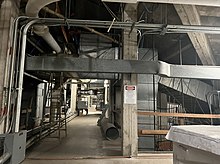Mechanical floor
**Structural and Functional Concerns:**
– Skyscrapers often have narrow building cores requiring stabilization.
– Outrigger trusses connect the core to supercolumns for stabilization.
– Triangular struts on truss sections house mechanical floors.
– Elevator zoning is based on the layout of mechanical floors.
– Overhead machine rooms for elevators are located in mechanical penthouses.
– Mechanical floors house HVAC systems, water pumps, tanks, fire safety equipment, and communication systems.
– Modern HVAC control systems enable centralized remote control.
– Mechanical floors are essential for building operations and functionality.
**Aesthetics and Design Considerations:**
– Mechanical floors require external vents for ventilation.
– Dark bands from vents can disrupt facade design.
– Different architectural styles address vent visibility differently.
– Modern styles incorporate vents as functional design elements.
– Postmodern styles aim to conceal vents through design features.
– Some buildings disguise mechanical floors as attics or towers for aesthetic purposes.
**Examples of Mechanical Floor Integration:**
– World Trade Center and Willis Tower showcase vents on mechanical floors.
– IDS Tower in Minneapolis uses mechanical floors for visual separation.
– Petronas Towers and Jin Mao Building integrate mechanical floors within the tower design.
– Taipei 101 and Jin Mao Building have ornamental non-glassed sections.
– Dodd Hall at UCLA disguises mechanical floors as attics or towers.
**Specific Building Mechanical Floor Breakdown:**
– Taipei 101: Floors 78, 1718, 2526, 34, 42 (17% of total).
– One World Trade Center: Floors 219, 9299, 103104 (26% of total).
– Willis Tower: Levels 2932, 6465, 8889, 104108, 109, 110 (13% of total).
– Petronas Towers: Floors 67, 3840, 43, 84, 8788 (10% of total).
– Burj Khalifa: Floors 1718, 4042, 7375, 109111, 136138 (15% of total).
**Significance of Mechanical Floors in Skyscrapers:**
– Mechanical floors are strategically located within the tower.
– They are crucial for the building’s infrastructure and functionality.
– The tower’s height accommodates multiple mechanical floors for various systems.
– Mechanical floors are not always included in the standard floor count but are essential for building operations.
This article needs additional citations for verification. (April 2022) |
A mechanical floor, mechanical penthouse, mechanical layer or mechanical level is a story of a high-rise building that is dedicated to mechanical and electronics equipment. "Mechanical" is the most commonly used term, but words such as utility, technical, service, and plant are also used. They are present in all tall buildings, including the world's tallest skyscrapers, with significant structural, mechanical and aesthetics concerns.

While most buildings have mechanical rooms, typically in the basement, tall buildings require dedicated floors throughout the structure for this purpose, for a variety of reasons discussed below. Because they use up valuable floor area (just like elevator shafts), engineers try to minimize the number of mechanical floors while allowing for sufficient redundancy in the services they provide. As a rule of thumb, skyscrapers require a mechanical floor for every 10 tenant floors (10%), although this percentage can vary widely (see examples below). In some buildings, they are clustered in groups that divide the building into blocks, while in others they are spread evenly through the structure, and in still others, they are mostly concentrated at the top.
Mechanical floors are generally counted in the building's floor numbering (this is required by some building codes) but are accessed only by service elevators. Some zoning regulations exclude mechanical floors from a building's maximum area calculation, permitting a significant increase in building sizes; this is the case in New York City. Sometimes buildings are designed with a mechanical floor located on the thirteenth floor, to avoid problems in renting the space due to superstitions about the number.
